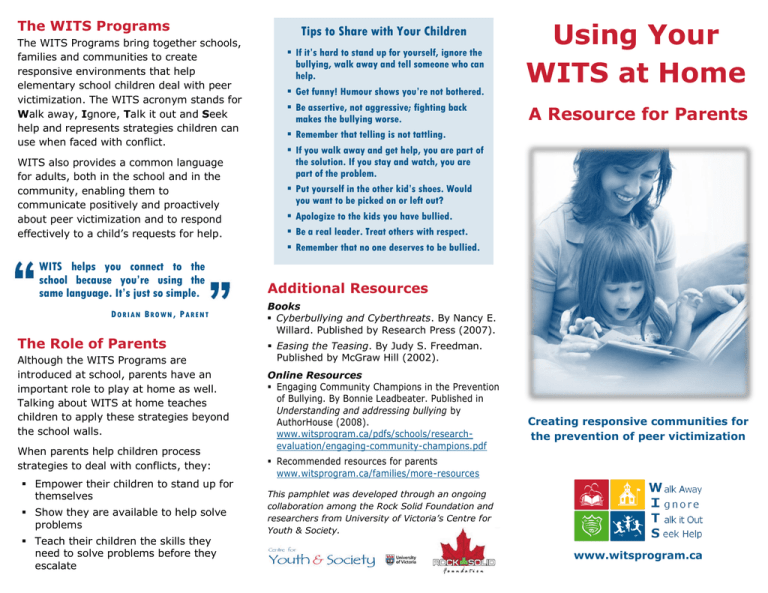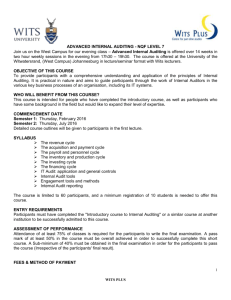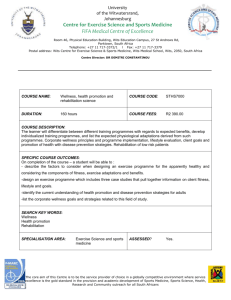Using Your WITS at Home Tips to Share with Your Children
advertisement

The WITS Programs The WITS Programs bring together schools, families and communities to create responsive environments that help elementary school children deal with peer victimization. The WITS acronym stands for Walk away, Ignore, Talk it out and Seek help and represents strategies children can use when faced with conflict. WITS also provides a common language for adults, both in the school and in the community, enabling them to communicate positively and proactively about peer victimization and to respond effectively to a child’s requests for help. WITS helps you connect to the school because you’re using the same language. It’s just so simple. DORIAN BROWN, PARENT The Role of Parents Although the WITS Programs are introduced at school, parents have an important role to play at home as well. Talking about WITS at home teaches children to apply these strategies beyond the school walls. When parents help children process strategies to deal with conflicts, they: Empower their children to stand up for themselves Show they are available to help solve problems Teach their children the skills they need to solve problems before they escalate Tips to Share with Your Children If it’s hard to stand up for yourself, ignore the bullying, walk away and tell someone who can help. Get funny! Humour shows you’re not bothered. Be assertive, not aggressive; fighting back makes the bullying worse. Remember that telling is not tattling. If you walk away and get help, you are part of the solution. If you stay and watch, you are part of the problem. Put yourself in the other kid’s shoes. Would you want to be picked on or left out? Apologize to the kids you have bullied. Be a real leader. Treat others with respect. Remember that no one deserves to be bullied. Using Your WITS at Home A Resource for Parents Additional Resources Books Cyberbullying and Cyberthreats. By Nancy E. Willard. Published by Research Press (2007). Easing the Teasing. By Judy S. Freedman. Published by McGraw Hill (2002). Online Resources Engaging Community Champions in the Prevention of Bullying. By Bonnie Leadbeater. Published in Understanding and addressing bullying by AuthorHouse (2008). www.witsprogram.ca/pdfs/schools/researchevaluation/engaging-community-champions.pdf Creating responsive communities for the prevention of peer victimization Recommended resources for parents www.witsprogram.ca/families/more-resources This pamphlet was developed through an ongoing collaboration among the Rock Solid Foundation and researchers from University of Victoria’s Centre for Youth & Society. www.witsprogram.ca How can you use the WITS Programs at Home? 1. Adopt the WITS Language at home – Remind your children to Walk away, Ignore, Talk it out and Seek help when competing for toys, television, who gets to go first, or for more serious problems like hitting, pushing, teasing and threatening. 2. Read WITS Books with your children – Borrow a WITS Book from your child’s school library. You can find a list of books online at www.witsprogram.ca/schools/book-lists/. When reading books or watching television with your child, pose questions that will reveal potential strategies to deal with conflicts. Questions may include: What problem do you think the main character has? 3. Watch television programs with your children and their friends Talk about the characters’ actions and choices in resolving conflicts. Was the problem something the main character could resolve alone or did he or she need help? 4. Use WITS Timeouts – A timeout is a great chance for children to Walk away and Ignore a conflict in order to think of a good solution. After a timeout period (one minute per year in age is a good guideline), discuss the conflict with your child alone and then together with a sibling or friend. Ask them to talk about how things got out of hand, how they could have used their WITS to avoid the conflict and how they would do things differently should another conflict arise. How do you know when to ask for help and when to work it out on your own? 5. Use WITS to solve your own conflicts – If your children see you using your WITS to deal with problems, they will better understand how WITS strategies can be used in many different situations and environments. 6. Offer praise when your children use their WITS – Encourage your children to continue using their WITS and to address conflicts positively and proactively. Four Steps for Solving Sibling or Peer Conflicts 1. Ask what the conflict is about. 2. Ask the children which of their WITS they could use to solve the conflict. They may need to try all the WITS strategies in order to find a resolution. 3. Ask what they think might happen if they used their WITS. 4. Talk about why using their WITS is a better choice than fighting. Have you ever had a similar problem or do you know someone who has? How was it resolved? What worked? What didn’t? How would you use your WITS to solve a similar problem in the future? How did the other characters act? How did their actions make the main character feel? Could they have chosen to act differently? Which of their WITS could they have used?




